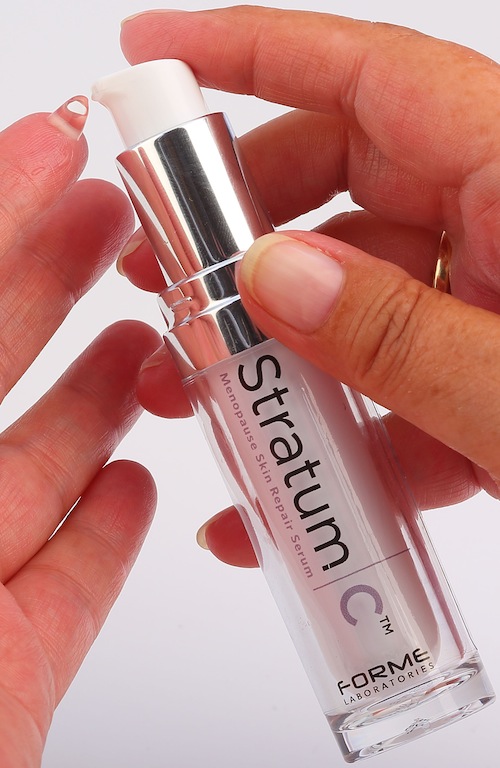Have you heard about Stratum C? Evidently, this wonder cream, formulated specifically for menopause skin, has been shown to relax facial muscles AND build collagen, while simultaneously moisturizing, promoting elasticity and providing a radiant glow. And, it has science to back it up, you know, an unpublished study conducted in a whopping 10 subjects.
Moreover, as the product restores that youthful glow that menopausal women so crave and erases signs of aging, it will only set you back $195. The thing is, to obtain the best results, evidently you need to use it from the start of menopause symptoms until the last symptom occurs. That’s an average of 10 years.
Want to know what’s in this magical cream?
“In addition to the collagen stimulating peptides Stratum C was formulated to contain Hyaluronic Acid to hydrate and moisturise the skin even into the lower levels of the dermis. Finally to combat existing wrinkles we included a muscle tightening ingredient that has been shown in clinical trials to reduce existing deep wrinkles by 45% in just one month.The base moisturiser in Stratum C is based on natural luxurious products well known to the beauty industry including Jojoba Oil, Seaweed and Apricot Oil the latter being a good source of Vitamin A and E which are also lost during the Menopause.”
In women in particular, aging is accompanied by a loss of estrogen, which has been linked with as great as a 30% loss of collagen in the dermis (the thick, sturdy layer of connective tissue that comprises about 90% of the skin’s thickness) within the first five years of menopause. Collagen, which is the most abundant protein in the body, is responsible for skin’s durability and strength. As it declines, skin starts to sag and wrinkles form. Oh, happy day!
There is absolutely no doubt that one of the peptides contained in this new cream and serum stimulates production of collagen and there are published studies demonstrating that. The question is, however, whether or not a cream or serum contains enough of the ingredient to perform the way that it claims to perform. And quite honestly, a majority of dermatologists will tell you that while a cream can help promote moisture and is necessary, it won’t reverse the ravages of environmental exposure built over the years. Estrogen, for example, has been shown to increase collagen, help the skin retain water and promote elasticity, yet its ability to reverse the effects of aging remain questionable.
I am all for looking as good as we possibly can at any age. A lot of that has to do with genes, sunscreen, diet and prior exposure. And I will be last person to judge someone who wants to drop a bunch of money on the promise of youth. Me? I’d rather save my dollars for something that is proven to work and until that happens, I’ll follow the directions of my dermatologist and preserve what I have got the best I can.
Buyer beware. This one sounds way too good to be true.








Having written websites for several face cream companies in the past few years, including proofing their ingredients lists (just capitalization and stuff, but still, you read them) I can’t say that this sounds very different from a lot of other “anti-aging” creams. I’d go with your Oil of Olay lines, or Revlon–somebody whose deep pockets have ACTUALLY invested in some ACTUAL research.
That said, I was disconcerted by the news this week that the acid peels we all love (and which work quite quickly to reduce wrinkles and spots–I just had my first a month ago and am pleased with results) may be carcinogenic. They’ve been around for years and we’re just now getting this warning?
Back in the 1920s, when radiation was discovered, a great many tonics and health products started to include radium. They were, of course, quite expensive; and as a result, the epidemics of mouth cancer and so on really only affected the rich. It’s a bit of a cautionary tale. Sometimes it’s best to stick to the ol’ Ponds Cream and take the wrinkles.